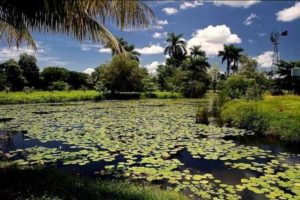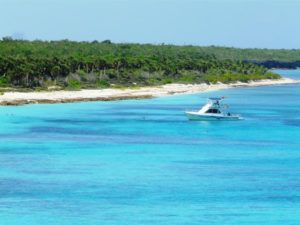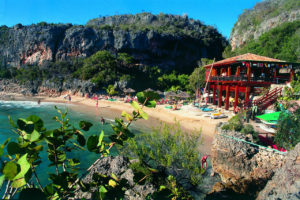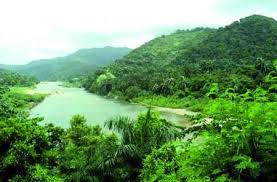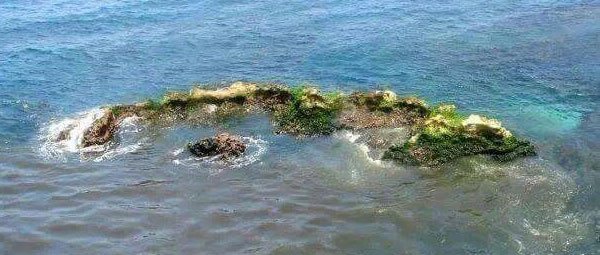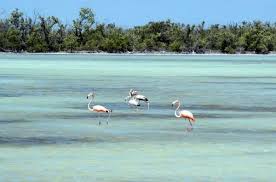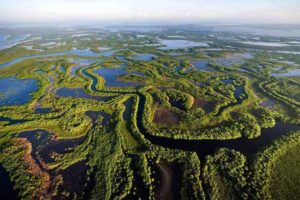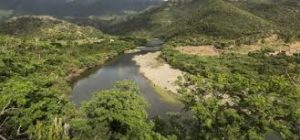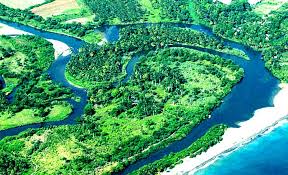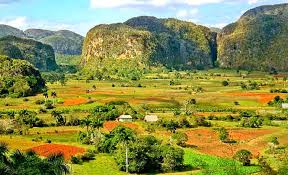 CUBA BIOSPHERE RESERVES, MOST BEAUTIFUL NATURAL SCENES OF THE ISLAND.
CUBA BIOSPHERE RESERVES, MOST BEAUTIFUL NATURAL SCENES OF THE ISLAND.
The geography of Cuba has six regions that stand out in the country for their rich flora and fauna and for all the endemic and endangered elements that live there, some of them unique only in Cuba. These are the six Biosphere Reserves of the Island and the six of the most beautiful settings of Cuban nature.
BUENAVISTA, CIEGO DE AVILA.
In the province of Ciego de Ávila is this wide area, the largest of the Cuban Reserves, with 880,860 hectares. Its fauna includes endemic species of the place and the Zaguanes-Santa María National Park is located there.
The Buenavista Biosphere Reserve, located between the provinces of Villa Clara, Sancti Spíritus, and Ciego de Ávila, Buenavista was declared a Biosphere Reserve in 2000. It has a territorial extension of 696. 95 km and 2499. 43 km of area Marine.
Buenavista has a great diversity of geographic regions that is reflected in the variety of terrestrial, coastal, and marine areas of great importance such as areas of high ecological sensitivity, high biodiversity, and notable genetic background, to which are added floristics, fauna, speleology and relevant landscaping.
The territory is internationally recognized as a Biosphere Reserve and Ramsar Site and includes the “Caguanes” and “Los Caimanes” National Parks, the “Las Loras” and “East of Cayo Santa María” Wildlife Refuges, the Outstanding Natural Features ” Dunes of Cayo Guillermo “,” Boquerón “,” La Chucha “and” Lomas de Tasajeras “and Protected Areas” Jobo Rosado “and” Buenavista “.
It has important habitats such as mangroves, coral reefs, active dune areas, and salt marshes. The area functions as a reservoir of varied species where fauna stands out, both resident and migratory in winter, mainly Nearthrope. 873 species have been cataloged, of which 176 are endemic and 20 local endemic. Of the total number of species, 25 are listed as threatened species according to the criteria of the World Conservation Union, and 20 are included in an appendix of CITES.
CIENAGA DE ZAPATA.
With 479,800 hectares, it is considered the largest wetland in the insular Caribbean. It is located south of Matanzas, on the Zapata Peninsula. Its vegetation is rich in forests, swamp grass, and coastal maniguas. It is the habitat of numerous species of animals, such as the ferminia, the swamp goat, the zunzuncito (the smallest bird in the world), the Santo Tomás chicken, the manatee, the Cuban jutia and the crocodile. There is the Ciénaga de Zapata National Park.
Ciénaga de Zapata is one of the 14 municipalities in the province of Matanzas, Cuba, and the municipal seat is located in Playa Larga, at the northern end of the Bay of Pigs (“Bay of Pigs”). Much of the municipality is protected as the Zapata Swamp. It is the largest municipality in Cuba with 4,162 km2.
PENINSULA DE GUANACABIBES.
The Guanahacabibes peninsula is the westernmost point of the island of Cuba. It is located in the province of Pinar del Río, in the municipality of Sandino, and is sparsely populated. The waters surrounding the peninsula are important fishing grounds for lobster and red snapper. It also has the category of Biosphere Reserve, cataloged by UNESCO in 1987. Its western end, Cabo San Antonio is the westernmost point of Cuba.
With an area of 101,500 hectares, its natural park comprises one of the most diverse territories, as it includes extensive beaches, swamps, peatlands, and mangroves.
SIERRA DEL ROSARIO.
The Sierra del Rosario is a mountain range in the provinces of Pinar del Río and Artemisa, in western Cuba. It is located in the eastern part of the Sierra de Guaniguanico and, together with the Sierra de los Órganos, is part of it. Among the municipalities of La Palma, Los Palacios, Consolación del Sur, Bahía Honda, Candelaria and San Cristóbal.
It was established as a Biosphere Reserve and Protected Area of Resources Managed by the IUCN on February 15, 1984, being the first in Cuba to be classified as such. It protects a total area of 266.86 km2 (103.04 square miles) of tropical forests with perennial and semi-deciduous environments.
More than 800 species of plants are found in the mesic forest that covers the mountains, 35% of which are endemic. The fauna includes five species of bats, numerous birds (especially the bee hummingbird), as well as the yellow-striped pygmy eleuth (Eleutherodactylus limbatus), several frogs such as Eleutherodactylus zeus and one of the smallest in the world, and several lizards such as Anolis luteogulartis. In it, there are a huge variety of orchids and more than 90 species of birds. Among them are the tocororo, the woodpecker, and the zunzún.
REGION OF BACONAO.
It is the second-largest reserve in the country – it covers some 770,760 hectares – and includes territories in the provinces of Santiago de Cuba and Guantánamo. In this area are located La Gran Piedra and the Meseta de Santa María, two of the highest Cuban elevations. It is a reserve for animals such as the batista hawk, the kestrel, and the quail.
The Baconao Biosphere Reserve is located in the Neotropic Province of the Greater Antilles, in the southeast region of Cuba, between Santiago de Cuba and the province of Guantánamo.
It includes three well-defined biogeographic zones: the Santiago Plateau, the Sierra de la Gran Piedra, and the Santa María de Loreto Plateau.
The Baconao Biosphere Reserve comprises mountainous rainforests, cloud forests, submontane mesophilic evergreen forests, and xeromorphic coastal and subcoastal microfilm evergreen shrub forests, with pine forests and column cactus. Rocky and sandy coastal habitats, mangroves, and cave ecosystems are considered other important habitats.
High biodiversity has been reported in flora (1,800 reported species) and fauna and many endemic endemic species such as bats, spiders, and insects that live in natural caves (46.6% of the ornithofauna).
CUCHILLAS DEL TOA.
The banks of the Toa river, in Holguín, limit this eminently mountainous region that reaches 127,500 hectares. Cuban nature reserve where some carnivorous plants and endangered species such as the almiquí, the real woodpecker, and the mannequin are protected. There the Alejandro de Humbolt National Park is located.
Cuchillas del Toa is a Biosphere Reserve in Cuba. It is located in the eastern part of the country, mainly in the province of Guantánamo, and reaches the north to the province of Holguín. Most of the reserve is established in the drainage area of the Toa River, which flows 118 km (73 miles) into the Atlantic Ocean at Baracoa.
Cuchillas del Toa is considered one of the main centers of biodiversity and endemism in Cuba and the insular Caribbean with pine forests, cloud forests, and xerophilous scrub to complex coastal vegetation with mangroves and coral reefs. The karst system of the great cave of Moa Headlands is one of the five natural monuments of the country and one of the great cave systems of eastern Cuba.
With high biodiversity in flora and fauna, there are 928 endemic species reported, including primitive species belonging to the genera Podocarpus and Dracaena. Cuchillas del Toa is home to the ivory-billed Cuban woodpecker (Campephilus principalis bairdii), the Cuban kite (Chondrohierax wilsoni), and the Cuban solenodon (Solenodon cubanus). Some of the smallest mammal species in the world are found in the reserve.
The reserve protects the tropical rainforest and coastal/marine ecosystems. It surrounds the Alejandro de Humboldt National Park and also contains El Yunque Table Mountain, Arroyo Infierno with a 300-meter (980-foot) waterfall, the Great Moa Cave (Great Moa Cavern), and Taco Bay, al north of Baracoa.
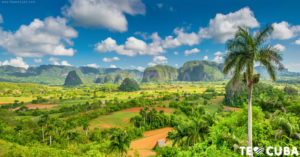 RESERVAS DE LA BIOSFERA DE CUBA Y ESCENAS NATURALES MÁS HERMOSAS DE LA ISLA.
RESERVAS DE LA BIOSFERA DE CUBA Y ESCENAS NATURALES MÁS HERMOSAS DE LA ISLA.
La geografía de Cuba tiene seis regiones que sobresalen en el país por su riquezas de flora y fauna y por todos los elementos endémicos y en peligro de extinción que viven allí, algunos de ellos únicos solo en Cuba. Estas son las seis Reservas de la Biosfera de la Isla y los seis de los escenarios más hermosos de la naturaleza cubana.
BUENAVISTA, CIEGO DE AVILA.
En la provincia de Ciego de Ávila se encuentra esta amplia zona, la mayor de las Reservas cubanas, con 880 860 hectáreas. Su fauna comprende especies endémicas del lugar y se ubica allí el Parque Nacional Zaguanes-Santa María.
La Reserva de la Biosfera Buenavista, Ubicada entre las provincias de Villa Clara, Sancti Spíritus y Ciego de Ávila, Buenavista fue declarada Reserva de la Biosfera en el año 2000. Tiene una extensión territorial de 696. 95 Km y 2499. 43 Km de área marina.
Buenavista cuenta con una gran diversidad de regiones geográficas que se refleja en la variedad de áreas terrestres, costeras y marinas de gran trascendencia como zonas de alta sensibilidad ecológica, alta biodiversidad y notable trasfondo genético, a las que se suman florística, faunística, espeleológica y paisajística relevante.
El territorio es reconocido internacionalmente como Reserva de la Biosfera y Sitio Ramsar e incluye los Parques Nacionales “Caguanes” y “Los Caimanes”, los Refugios de Vida Silvestre “Las Loras” y “Este de Cayo Santa María”, los Elementos Naturales Destacados “Dunas de Cayo Guillermo “,” Boquerón “,” La Chucha “y” Lomas de Tasajeras “y Áreas Protegidas” Jobo Rosado “y” Buenavista “.
Tiene hábitats importantes como manglares, arrecifes de coral, áreas activas de dunas y marismas. La zona funciona como un reservorio de especies variadas donde destaca la fauna, tanto residente como migratoria de invierno, principalmente del Neartropo. Se han catalogado 873 especies, de las cuales 176 son endémicas y 20 endémicas locales. Del número total de especies, 25 están incluidas como especies amenazadas de acuerdo con los criterios de la Unión Mundial para la Naturaleza y 20 están incluidas en algún apéndice de la CITES.
CIENAGA DE ZAPATA.
Con 479 800 hectáreas, es considerada el mayor humedal del Caribe insular. Se encuentra al sur de Matanzas, en la Península de Zapata. Su vegetación es rica en bosques, hierbazal de ciénaga y maniguas costeras. Constituye el hábitat de numerosas especies de animales, como la ferminia, el cabrerito de ciénaga, el zunzuncito (ave más pequeña del mundo), la gallinuela de Santo Tomás, el manatí, la jutia cubana y el cocodrilo. Allí se encuentra el Parque Nacional Ciénaga de Zapata.
Ciénaga de Zapata es uno de los 14 municipios de la provincia de Matanzas, Cuba, y la cabecera municipal está ubicada en Playa Larga, en el extremo norte de la Bahía de Cochinos (“Bahía de Cochinos”). Gran parte del municipio está protegido como el Pantano de Zapata. Es el municipio más grande de Cuba con 4.162 km2.
PENINSULA DE GUANACABIBES.
La península de Guanahacabibes es el punto más occidental de la isla de Cuba. Se ubica en la provincia de Pinar del Río, en el municipio de Sandino y está escasamente poblada. Las aguas que rodean la península son importantes caladeros de langosta y pargo colorado. También cuenta con la categoría de Reserva de la Biosfera, catalogada por la UNESCO en 1987. Su extremo occidental, Cabo San Antonio es el punto más occidental de Cuba.
Con una extensión de 101 500 hectáreas, su parque natural comprende uno de los territorios más diversos, pues comprende extensas playas, pantanos, turbas y manglares.
SIERRA DEL ROSARIO.
La Sierra del Rosario es una cadena montañosa en las provincias de Pinar del Río y Artemisa, al occidente de Cuba. Se ubica en la parte oriental de la Sierra de Guaniguanico y, junto con la Sierra de los Órganos, forma parte de ella. Entre los municipios de La Palma, Los Palacios, Consolación del Sur, Bahía Honda, Candelaria y San Cristóbal.
Fue establecida como Reserva de la Biosfera y Área Protegida de Recursos Manejados por la UICN el 15 de febrero de 1984, siendo la primera en Cuba en ser clasificada como tal. Protege un área total de 266,86 km2 (103,04 millas cuadradas), de bosques tropicales con ambientes perennes y semideciduos.
Más de 800 especies de plantas se alojan en el bosque mésico que cubre las montañas, siendo el 35% endémico. La fauna incluye cinco especies de murciélagos, numerosas aves (especialmente el colibrí abeja), así como el eleuth pigmeo de rayas amarillas (Eleutherodactylus limbatus), varias ranas como la Eleutherodactylus zeus y una de las más pequeñas del mundo, y varios lagartos como como Anolis luteogulartis. En ella se encentran una enorme variedad de orquídeas y más de 90 especies de ave. Entre ellas destacan el tocororo, el pájaro carpintero y el zunzún.
REGION DE BACONAO.
Es la segunda mayor Reserva del país –abarca unos 770 760 hectáreas- y comprende territorios de las provincias de Santiago de Cuba y Guantánamo. En esta área se ubican La Gran Piedra y la Meseta de Santa María, dos de las mayores elevaciones cubanas. Es reserva de animales como el gavilán batista, el cernícalo y la codorniz.
La Reserva de la Biosfera Baconao se encuentra ubicada en la Provincia Neotrópica de las Antillas Mayores, en la región sureste de Cuba, entre Santiago de Cuba y la provincia de Guantánamo.
Incluye tres zonas biogeográficas bien definidas: la Meseta de Santiago, la Sierra de la Gran Piedra y la Meseta Santa María de Loreto.
La Reserva de la Biosfera de Baconao comprende bosques montañosos lluviosos, bosques nubosos, bosques submontanos mesófilos perennifolios y bosques arbustivos xeromórficos costeros y subcosteros siempreverdes microfilo, con bosques de pinos y cactus columna. Los hábitats costeros rocosos y arenosos, los manglares y los ecosistemas de cuevas se consideran otros hábitats importantes.
Se ha reportado una alta biodiversidad en flora (1.800 especies reportadas) y fauna y muchas especies endémicas amenazadas como murciélagos, arañas e insectos que viven en cuevas naturales (46.6% de la ornitofauna).
CUCHILLAS DEL TOA.
Las riveras del rio Toa, en Holguín, limitan a esta región eminentemente montañosa que alcanza las 127 500 hectáreas. Reserva de la naturaleza cubana donde se protegen algunas plantas carnívoras y especies en extinción como el almiquí, el carpintero real y el maniquí. Allí se ubica el Parque Nacional Alejandro de Humbolt.
Cuchillas del Toa es una Reserva de la Biosfera en Cuba. Se ubica en la parte oriental del país, principalmente en la provincia de Guantánamo y llega al norte a la provincia de Holguín. La mayor parte de la reserva está establecida en el área de drenaje del río Toa, que fluye a lo largo de 118 km (73 millas) hacia el Océano Atlántico en Baracoa.
Cuchillas del Toa es considerada como uno de los principales centros de biodiversidad y endemismo en Cuba y el Caribe insular con pinares, bosques nubosos y matorrales xerófilos hasta vegetación costera compleja con manglares y arrecifes de coral. El sistema kárstico de la gran cueva de tierras de Moa Head es uno de los cinco monumentos naturales del país y uno de los grandes sistemas de cuevas del oriente cubano.
Con alta biodiversidad en flora y fauna, existen 928 especies endémicas reportadas, incluyendo especies primitivas pertenecientes a los géneros Podocarpus y Dracaena. Cuchillas del Toa es el hogar del pájaro carpintero cubano pico de marfil (Campephilus principalis bairdii), el milano cubano (Chondrohierax wilsoni) y el solenodonte cubano (Solenodon cubanus). Algunas de las especies de mamíferos más pequeñas del mundo se encuentran en la reserva.
La reserva protege el bosque húmedo tropical y los ecosistemas costeros / marinos. Rodea el Parque Nacional Alejandro de Humboldt y también contiene la montaña de la mesa El Yunque, el Arroyo Infierno con una cascada de 300 metros (980 pies), la Gran Cueva de Moa (Gran Caverna de Moa) y la Bahía de Taco, al norte de Baracoa.
Agencies/ Wiki/ TodaCuba/ Internet Photos/ Arnoldo Varona/ www.TheCubanHistory.com
THE CUBAN HISTORY, HOLLYWOOD.



 CUBA Biosphere Reserves, Most Beautiful Natural Scenes of the Island. * RESERVAS de la Biosfera de Cuba y Escenas Naturales Mas Hermosas de la Isla. PHOTOS.
CUBA Biosphere Reserves, Most Beautiful Natural Scenes of the Island. * RESERVAS de la Biosfera de Cuba y Escenas Naturales Mas Hermosas de la Isla. PHOTOS.
